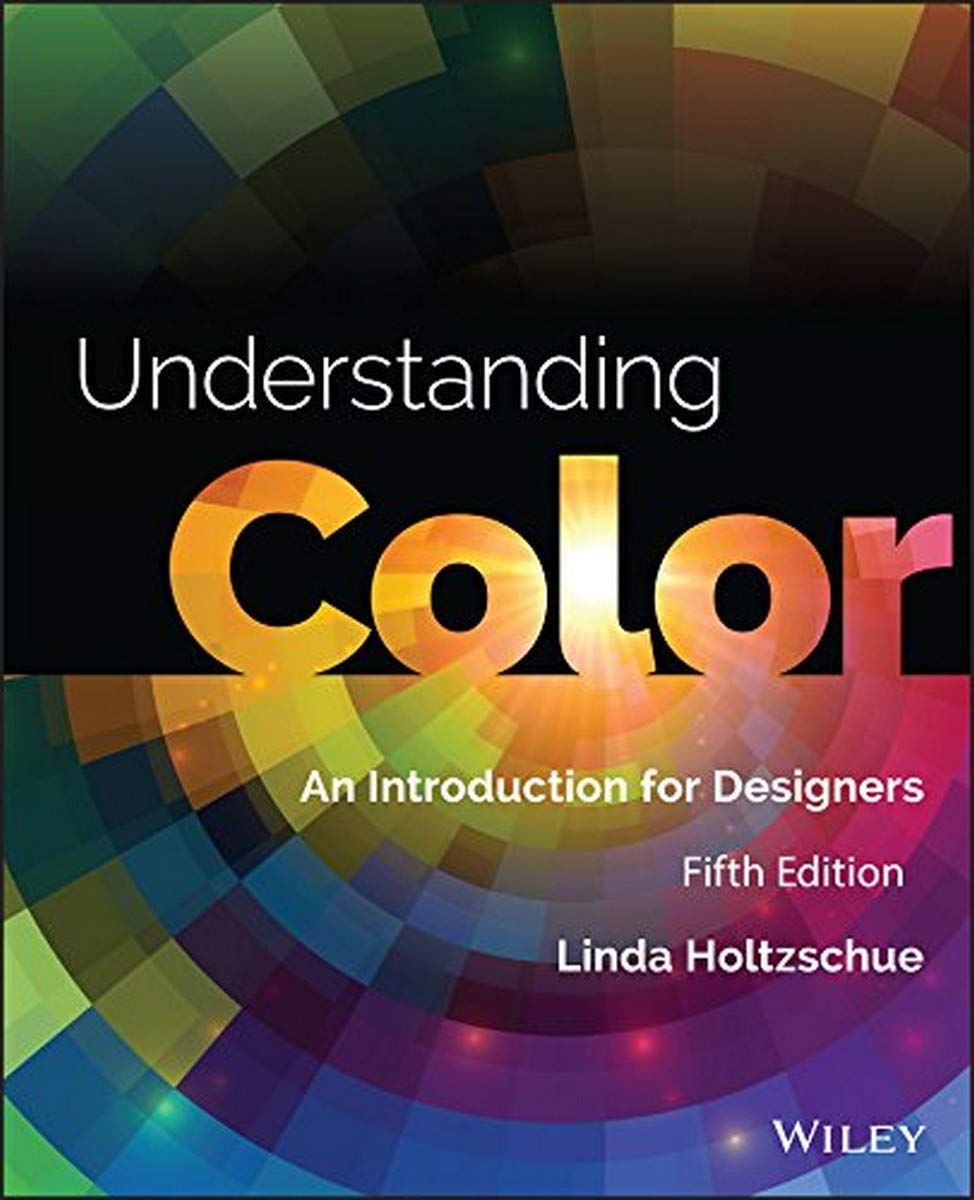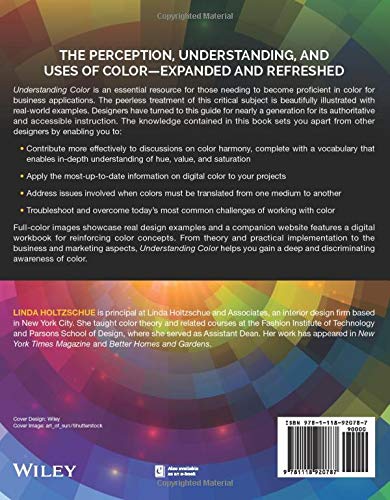Customer Services
Copyright © 2025 Desertcart Holdings Limited
Desert Online General Trading LLC
Dubai, United Arab Emirates



Full description not available
F**Y
Just what I needed.
I needed this book for school and it came in great condition.
A**T
Not just for designers
I got this book in one of the humblebundle bundles. I really liked this book and the content it covers. I was thinking that this book would cover an elaborate discussion of basic color theory available on the internet but this book went into much more detail and different aspects of choosing colors and understanding their influence on each other as well as their surroundings.WHO SHOULD READ THIS BOOKEven though the title of this book mentions "An introduction for designers", I think anyone should be able to read and understand this book. This book does not use assume any knowledge of terminology specific to the design field but explains them thoroughly e.g. the difference between hue, saturation of value are explained in detail in this book. If you have an interest in learning about color and how they influence each other, this would be a good book to read.WHO SHOULD NOT READ THIS BOOKThis book does not go into too much detail of actual color combinations that work well together or explains any tools for designers. Most of the contents of this book are theoretical and you would have to explore tools or software on your own to actually implement the basics discussed in this book e.g. this book does discuss color harmonies but does not give extensive examples of which colors schemes would work well together or this book does not discuss tools or software available to achieve color harmonies. So if you expect this book to provide you some pre-defined templates for choosing colors in your project then this book might not be right for you. If you are looking for a book that helps you in selecting color swatches then I would recommend which has lots of color schemes and swatches that you can use.WHAT DOES THIS BOOK CONTAINI found that this book contains lots of information about colors that I usually would not think about. This book contains a little bit of history about the colors, ways of classifications of colors, color forecasting, psychological effects of colors etc. What I found most useful in this book was the explanation of additive vs subtractive colors and challenges required in these two media of colors. This book goes into detail of explanation of hue, saturation, and value properties of colors and how they impact the color choosing process. This book covers a lot of aspects that span multiple fields e.g. spatial effects of colors that might be relevant to interior designing, color mixing properties that are relevant to painting, color display modes that might be relevant to wen/graphic designing. This book gives a nice introduction to the basics of colors but you would still have to venture out and do more study to figure out how to apply all this information in your field or project.I would recommend this book to you if you are interested in learning theory and basics about color harmonies. After reading this book you might be able to understand better why some colors work well together and why some colors should not be used together. Having a copy of a book like that contains a lot of color swatches that can be used together and this book will help you understand why the color swatches work well together.
J**L
Comprehensive look at the meaning, uses, history and physiology of color
This is a terrific book on the history, uses and meaning of color and it's just chock full of good solid information. I will say at the outset though that it's essentially a textbook and a tad dry, so I really can't see too many people reading it for sheer pleasure, but then again, that's probably not the intent of the book. The book is primarily a comprehensive look at the psychology of color, it's uses (traditional and current) in various forms (printing, fabrics, fine arts, etc.) and I'd say that for students this is a very worthwhile read--and a good book to have on your shelf for future reference.I'm a professional photographer and I've had a lifelong fascination with color and color theory. I've also written my own book on color for photographers: The Photographer's Master Guide to Color. To be honest, I wish I'd had this book handy when I was writing mine. I spent a long hot summer researching the history of color theory and this book's chapter on the history of theory provides a nice outline that no doubt would have saved me some time. (All I remember about that summer is being in a house with no air conditioning for the hottest summer in 20 years and reading dozens and dozens of books on color. It was fun and interesting, but also miserable, lol.) Anyway, I found a lot of similarities between this book and mine and what the author (Linda Holtzschue) and I chose to focus on in the history section. It's not like you can change history, but you can cherry pick certain events/philosophies in history and she and chose a lot of the same things to highlight.I'm very glad that this book brings up artists and visionaries like Joseph Albers (who I was lucky enough to meet a few times at Yale long ago) whose work had a profound influence on my decision to be a photographer. In fact, this book has a lot of great information on the "interaction of color" (an Albers' phrase) and how colors work together. I find the topic fascinating and it's really interesting to read more about it here. The book also has a wonderful chapter on the "Vocabulary of Color" and an equally good chapter about color and human physiology. Understanding how the brain perceives color is a crucial aspect of understanding color and learning how to use it in reproduction, photography and fine art. The chapter on color harmony is also very good.The book is very well organized, brief enough on each topic to keep your interested without putting you to sleep and is very comprehensive in its scope (it's a Wiley book, all Wiley books are super well organized--I've written a few books for them, full discolosure). It really is one of the best books on color that I've read and I think that if you're considering a career in fine arts, graphic arts, art history or photography, you'll learn a lot from this book. Yeah, the writing is a tad dry and I really wish the author would have put herself in there a bit (I like first-person narratives even in textbooks, they make the readability factor soar), but that's a tough juggling act when you are trying to write a text book.Anyway, if you have color in your life and you want to know more about it, or if you have a child who is heading off to art school or to a photo career, this is a great book. And so is mine!
J**Y
Thorough and Useful Overview of Color Theory and Practice
Though I'm not a designer, I am a photographer and felt a need to understand the theory and science or color a little more since controlling how color is rendered throughout the photography process is so important. Though the book has some quite technical sections, the technical stuff is presented in a very approachable way, with plain-language descriptions and plenty of effective illustrations.The topics include: 1) An Introduction to Color Study; 2) A Little Light on the Subject; 3) The Human Element; 4) The Vocabulary of Color; 5) The Instability of Colors; 6) Illusion and Impression; 7) Color Theory: A Brief History; 8) Color Harmony; 9) Tools of the Trade: Color in Product and Print; 10) The Medium of Light; 11) The Business of Color.A Glossary, Bibliography and Index make it easy to find info on specific topics. Whether you intend to read the book from cover to cover or just delve into a specific topic, you will find what you need to know about color in this comprehensive book. The layout is clean and attractive with wide margins (great for note-taking) and plenty of effective and well-designed full-color illustrations. The only negative aspect of the book for me is the tiny font used - it really is a strain to read the text.
H**E
Received with a scratched front cover
I was disappointed that given the price of this book AUD110.00 that the book arrived with scratches on the cover.
M**L
Really Colourful Insight into.... Colour
For designers, particularly interior designers, and I would think for artists, this book of Understanding Colour makes an interesting and innovative read.Setting out in Chapters, covering and Introduction to Colour Study, a Little Light on the Subject, the Human Element, the Instability of Colours, Illusion and Impression, a Brief History.... this book gives you some new ideas, some new perspectives on colour.Colour is something most of us just "know" is there, but this book gives you insights into why colour works, and how.With illustrations showing how colour works - for example in safety situations, danger situations, as well as in nature.A really excellent book, one you can dip in and out of, and one you can sit and read a particular chapter to figure something out.Nicely written, well illustrated, good use of colour
W**R
Comprehensive.....
The book arrived well packaged and in perfect condition. My initial observations… being in its 5th edition it must be a popular and useful publication particularly as it is currently retailing at around £ 50.00. The book is very detailed on the theory of colour and would certainly be worth getting for anyone involved in art and design. There are lots of very relevant illustrations. The book did seem more technical and theoretical rather than creative, but it would certainly make a very useful reference book that covers the topic in great detail. A fairly expensive but comprehensive book for teachers, students and designers.
J**�
Understanding Colour.
“An Introduction for Designers” is the subtitle of this volume, and that pretty much describes the aims and scope of this book.As a painter I have a good understanding of colour as it applies to my own particular discipline; this useful reference covers a good deal of the colour theory, perception and practical uses of colour. It also considers specific aspects such as the more commercial applications of colour in product design and touches on the way our brains perceive colour and the psychological effects it has on us.Much of the basic content here can be found in general art instruction books; the difference between colour as paint and colour as light (as it appears on a computer monitor) is clearly explained, which will be relevant to digital artists/designers.It isn't a technically difficult, scientifically oriented book – more of a practical, working guide for artist/designers who require an easy-to-follow digest to keep at hand.A useful volume for the practising artist/designer/crafts person who deals with colour or those who simply wish to know more about how it works and how to use it effectively. Do use the “look inside” option above for an idea of the contents.
N**N
Dry, theory-based text
I'm a professional photographer, and was looking for some deeper and practical insights into colour both for in my photography, and for helping me design my marketing materials.I struggled with this book, finding the writing style dry and long-winded, and as a result it took me a long time to finish it. It is very theoretical, lacking in tips for practical explanation.
Trustpilot
2 weeks ago
1 month ago